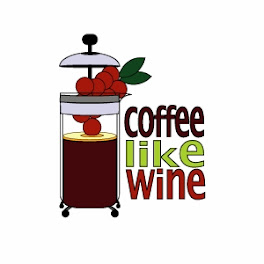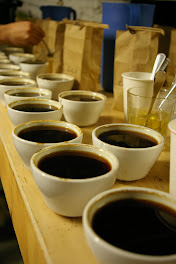This is a weird one. I walked into a small, sort of dingy shop in Oakland where I had heard there were many good microbrews. I was looking to stock up on some odd and unique beers for a pizza and brew night with another couple when I came across a shelf near the register of a wine with a simple red label with white lettering that said "Il Barbaresco."
Didn't see anything else except the DOCG ring on the top of the bottle. On the back is the producer's name, "Tenuta San Mauro," and the year 1997. The price? just $3.99. Yes, that's not $39.99 or $399.99, but a measily four bucks.
"What the deal with this wine?" I asked, incredulously, to the shop keeper.
"Oh yes it's very good," he said. But how did he get it? Was a distributor dumping unsold older wines? Was it a fire sale? Were they actually in a fire? I had tons of questions and no one to really ask, since the clerk didn't seem aware of the wine's history. The shop's wine selection itself was much less impressive than it's amazing beer offerings. Most of the wine bottles were under $10-mass produced picks that you'll find at any corner liquor store. So suddenly out of no where they're pulling out a 1997 Barbaresco? The bottle looked brand new too, and in fact I assumed it was either a non-vintage (which I'm not even sure they make for Barbarescos) or some misprint with the label. Why would the vintage be on the back? And again, how did this little shop get the wine? WTF?
Barbaresco is made from the Nebbiolo grape, the same grape used to make Italy's famed Barolos. Known for it's spiciness and rich cherry flavors, Barbarescos are considered more feminine than Barolos, though they can get expensive, and can age for decades. Just looking at wine searcher, I see about two dozen 1997 Barbarescos priced from $30 to $112.
The Nebbiolo grape can make extremely tannic wines, with high acidity and sour flavors, so if you drink them too young, they can be unappealing. DOCG status means this wine had to see at least two years of aging (at least one year in oak) before being released, and the grapes must come from Italy's northwestern Piedmont region.
Anyway, I jumped at the chance to try a 12-year old Barbaresco for $3.99. If it was horrible, oxidized, or somethinge else, then I'm not losing out that much.
What I got was a mixed bag. When I poured this wine, I saw a pretty brick color, indicating the wine has seen some age. After letting it get some air, I found massive earthy aromatics, with tobacco leaf dominating other aromas of nutmeg and menthol.
"Wonderful nose - could sniff for hours," I wrote in my journal. Got me all hot and bothered for some awesome aged Barbaresco for four freakin' dollars!!!!!!
Yet this where the disappointment set in. The wine itself tasted a lot like the aromas I found in the nose -- tobacco leaf, mixed spices, mentol, but after a strong attack, the wine fell apart on the mid palate, and ended in a mess of sour sour cherry and dry, busted tannins. The end result didn't even taste like it was wine - there was no fruitiness, no freshness or life at all.
Sigh.
Well, I'm not sad I took a chance on this, and I might even buy another bottle to see if the result is any different. The reason why I wrote this as a posting is because despite the bad vino, I love the sense of discovery that you can have with bottles like these. While I can't find any info on the producer at all online, or vintage reports from the most recent books, it's still sort of like opening a time capsule and seeing what has been stored in the bottle for all those years.
Friday, November 27, 2009
Subscribe to:
Post Comments (Atom)









No comments:
Post a Comment